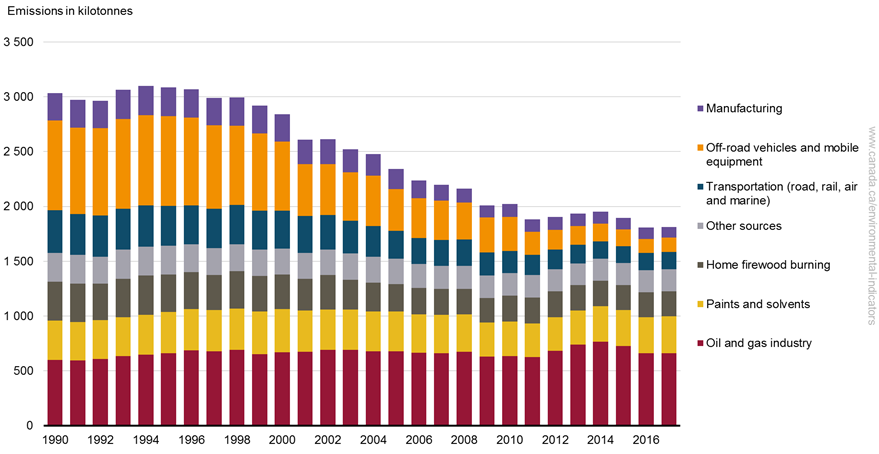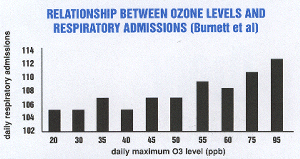Health Effects of Ground Level Ozone
The ozone layer in the upper atmosphere is beneficial, protecting us from harmful ultraviolet radiation, However, ground-level ozone is bad for our health. We do not directly pollute the atmosphere with ozone. It is generated when emissions of nitrogen (NOx) and volatile organic compounds (VOCs) react in the presence of sunlight. Ozone accumulates around cities on hot summer days. Since NOx and VOCs can travel long distances, ozone also builds up in rural areas. In fact, about half of the NOx and VOCs in the province come from American sources.
Total volatile organic compound emissions by source, Canada, 1990 to 2017

(Image and data from Government of Canada, https://www.canada.ca/en/environment-climate-change/services/environmental-indicators/air-pollutant-emissions.html , Retrieved June 4, 2019)
Total nitrogen oxide emissions by source, Canada, 1990 to 2017

(Image and data from Government of Canada, https://www.canada.ca/en/environment-climate-change/services/environmental-indicators/air-pollutant-emissions.html , Retrieved June 4, 2019)
Health Effects
Ozone Reduces Lung Function
People have difficulty breathing when ozone levels rise. It is not generally realized that in the summer, ozone impacts rural and suburban areas even more than cities in Southern Ontario. Ozone reduces lung function, even at levels equal to the one hour standard of 80 parts per billion (ppb). Studies of human subjects exposed for several hours to ozone in controlled chambers have shown a definite “dose-response” relationship: the greater the dose of ozone, the greater the reduction in pulmonary function. These have been summarized by Hazucha (1987)* and Larsen (1991)*. Current summer ozone levels in Ontario likely temporarily reduce lung function in sensitive people.
Ozone can put you in the hospital
More people are admitted to hospital for respiratory problems on or just after higher ozone days. This effect can be shown at low concentrations of ozone. Bates and Sizto’s classic 1983* study showed that as the concentration of ozone increased, so did the number of respiratory admissions in hospitals across Ontario. This effect is demonstrated most easily during hot summer months, ozone is particularly harmful to people with respiratory conditions such as asthma or chronic bronchitis etc. These groups are more likely to be admitted to hospital during higher ozone days. Numerous studies have shown effects with healthy individuals as well. Also, since ozone easily spreads as a result of urban pollution to rural areas, it affects everyone.
Ozone precursors also affect us

Did you know?
- The current Ontario Ambient Air Quality Criterion for ozone is 80 ppb (parts per billion) for a one hour period. In 2017, ozone exceeded 50ppb 352 times.
- The 2017 Canadian emissions for VOC’s and nitrogen oxide were 1811.2 kilotonnes of VOCs and 1782.9 kilotonnes of nitrogen oxide1.
What can you do?
PROTECT YOURSELF: If levels are high do not exercise vigorously outside. Go indoors if necessary.
BE INFORMED: Request information from local government, the Ministry of the Environment, Conservation and Parks, Environment Canada, plant managers and environmental groups.
BE INVOLVED: Reduce your own emissions: use public transportation, car pool, walk, rollerblade or cycle. If you do drive, keep your car well-tuned. Practice energy conservation. By solvent-free household products. Start or join a citizen’s group. Write letters to the Minister of Environment, Conservation and Parks and to your local MPP. Register complaints about air quality with the Ministry of Environment, Conservation and Parks online or at 1-866-663-8477.
1 Government of Canada, https://www.canada.ca/en/environment-climate-change/services/environmental-indicators/air-pollutant-emissions.html , Retrieved June 4, 2019

